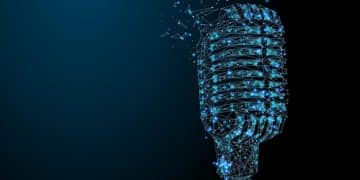Spotify’s Podcast Strategy: Acquisitions Impact on Independent Creators

Spotify’s aggressive podcast acquisition strategy has reshaped the audio landscape, promising enhanced reach and monetization opportunities for some creators while raising significant concerns about platform exclusivity, creative freedom, and the long-term viability for independent podcasters outside its ecosystem.
Spotify’s podcast strategy: Analyzing the impact of recent acquisitions on independent creators reveals a complex and evolving dynamic within the audio industry. Over recent years, Spotify has aggressively moved to dominate the podcasting space, investing billions in exclusive content and infrastructure. This strategic shift has undoubtedly garnered significant attention, prompting both excitement and apprehension among podcasters, particularly those operating independently.
The Genesis of Spotify’s Podcast Ambitions
Spotify, initially known for music streaming, recognized early on the immense potential of podcasts. This realization was primarily driven by the understanding that audio content extends beyond music, offering a vast, untapped market for engagement and advertising revenue. The company observed the increasing listener numbers and the deeply personal connection many form with their favorite podcast hosts.
The foundational shift began with high-profile acquisitions designed to rapidly secure market share and establish Spotify as a premier destination for spoken-word content. These moves were not merely about adding shows; they were about integrating entire ecosystems and technologies that would bolster Spotify’s competitive edge. The goal was to diversify its content offerings, reduce reliance on music licensing, and solidify its position as king of audio.
This aggressive expansion, while a clear business strategy, has profoundly affected the podcasting landscape. It raised immediate questions about the future of open podcasting, where RSS feeds allowed content to be distributed freely across multiple platforms. Spotify’s pivot towards exclusivity signaled a potential walled garden approach, much like traditional media networks but applied to the digital audio realm.
Early Acquisitions and Their Rationale
- Gimlet Media: Acquired in 2019, Gimlet brought a critically acclaimed studio known for narrative storytelling and high-quality productions, immediately elevating Spotify’s original content portfolio.
- Anchor: Also acquired in 2019, Anchor provided a user-friendly platform for podcast creation and hosting, democratizing access to podcasting for millions of new and independent creators. This acquisition was pivotal in attracting a broad base of users.
- Parcast: Adding to its content arsenal, Parcast offered a unique catalog of true-crime and mystery shows, further broadening Spotify’s appeal to diverse listener demographics.
These initial acquisitions laid the groundwork for Spotify’s ambitious vision. They provided a strong content library, robust creation tools, and analytics capabilities, forming the core infrastructure for its podcasting dominance. This strategic blueprint aimed to create a self-sustaining ecosystem where creators could produce, distribute, and monetize their content all within the Spotify framework.
The company’s investment demonstrated a clear belief that podcasts would become a significant driver of user engagement, subscription retention, and advertising revenue. This foresight has largely paid off, with podcast listening growing substantially on the platform, reinforcing the validity of their early, bold moves.
The Era of Exclusivity: High-Profile Deals and Their Ramifications
Following its initial infrastructure and studio acquisitions, Spotify embarked on a spree of high-profile exclusive content deals. These were designed to draw massive audiences to the platform, leveraging the star power of celebrities and influential personalities. The strategy was simple: if a listener wanted to hear a specific popular podcast, they would have no choice but to use Spotify.
The signing of Joe Rogan, for an estimated $200 million, was perhaps the most significant and controversial of these deals. His massive audience instantly shifted listening habits towards Spotify, proving the power of exclusive content. This was followed by deals with other prominent figures, including Michelle Obama, Call Her Daddy, Lex Fridman, and Dax Shepard, among others. Each acquisition brought a dedicated fanbase, further cementing Spotify’s position as a podcasting giant.
These exclusive agreements had immediate and profound ramifications for the broader podcast ecosystem. For independent creators, the landscape began to change rapidly. While some saw opportunities to eventually be “discovered” by Spotify, many more felt the pressure of competing against well-funded, exclusive content that was actively driving listeners away from open RSS feeds. The fear grew that the open nature of podcasting was being eroded.
The deals also sparked debates about censorship, content moderation, and the responsibilities of platforms hosting such influential voices. Spotify faced scrutiny over certain content on its exclusive shows, highlighting the complexities of being both a distributor and a publisher.
Impact on Discoverability and Audience Migration
One of the primary concerns for independent podcasters was the impact on discoverability. When popular shows move behind a paywall or onto an exclusive platform, it fragments the audience. Listeners, accustomed to finding all their podcasts in one app, now had to navigate multiple platforms. This led to a mass migration of listeners to Spotify, sometimes at the expense of other podcast apps.
Independent creators, who typically rely on broad distribution through RSS feeds to maximize their reach, found themselves in a more competitive environment. Search algorithms on general podcast directories might prioritize shows based on listener numbers, which could be skewed by exclusive deals. This made it harder for newer or smaller independent shows to break through the noise.
The dominance of exclusive content also influences advertising revenue. Advertisers tend to gravitate towards platforms with the largest, most engaged audiences. As Spotify consolidated listening, it also consolidated ad revenue, potentially making it more challenging for independent shows to secure sponsorships outside of Spotify’s network.
This dynamic creates a two-tiered system: mega-creators benefiting from exclusive deals and widespread marketing by Spotify, and independent creators battling for crumbs in an increasingly competitive and fragmented market. The core issue revolves around whether the entire pie is growing fast enough for everyone to thrive, or if Spotify’s growth is coming at the expense of independent growth.
Monetization and Economic Realities for Independents
The economic landscape for independent podcasters has always been challenging. Unlike traditional media, podcasting offered a relatively low barrier to entry, but a high barrier to sustainable monetization. Spotify’s acquisitions and strategy have further complicated this picture, presenting both potential opportunities and significant hurdles for independent creators.
Spotify has introduced various monetization tools for creators on its platform, including podcast subscriptions, host-read ads through its Spotify Audience Network, and direct support mechanisms. For some independent creators, integrating with Anchor (now part of Spotify) and utilizing these tools has simplified the process of earning revenue. It provides a structured pathway to monetization that might be otherwise inaccessible to smaller operations.
However, the economic realities are often stark. While Spotify boasts about the total ad revenue generated, the proportion that trickles down to independent creators, especially those outside its direct network or exclusive deals, can be minimal. The sheer volume of content available means that only a fraction of shows achieve significant listenership to attract high-paying advertisers.
There’s also the question of leverage. When an independent creator relies solely on Spotify for distribution and monetization, they become highly dependent on the platform’s terms and algorithms. This can limit their negotiating power and creative control compared to maintaining broad distribution across multiple platforms. The promise of greater reach through Spotify might come at the cost of long-term independence.

The Promise vs. The Pitfalls of Platform Tools
- Simplified Monetization: Tools like Anchor’s monetization features and the Spotify Audience Network aim to make it easier for smaller podcasts to earn money through automated ad placements.
- Listener Analytics: Spotify offers detailed analytics, providing creators with valuable insights into their audience demographics and listening habits, which can help tailor content and attract advertisers.
- Exclusivity Demands: While not mandatory for all, the lure of Spotify’s exclusive deals often comes with demands for platform-specific content or advertising, potentially limiting multi-platform exposure.
- Competition for Ad Dollars: Independent creators face intense competition for ad revenue, not just from other podcasts but from the highly polished, Spotify-backed exclusive shows that attract premium advertisers.
Ultimately, the monetization landscape for independent creators on Spotify is a mixed bag. For those just starting out or with niche audiences, the platform offers accessible tools and a vast listener base. However, for established independents or those with aspirations of significant earnings, the road remains challenging, often requiring a blend of platform tools, direct ad sales, and audience support outside of Spotify’s immediate ecosystem.
Independent Creators’ Adaptations and Innovations
Faced with Spotify’s dominant strategy, independent creators have not simply withered away. Instead, many have adopted a spirit of resilience and innovation, finding new ways to thrive within this evolving landscape. This often involves a multi-pronged approach that leverages the open nature of podcasting while selectively engaging with larger platforms.
One key adaptation is diversification. Independent podcasters are increasingly looking beyond single-platform reliance. This means distributing their shows via RSS feeds to all major podcast directories (Apple Podcasts, Google Podcasts, Stitcher, etc.) to ensure maximum reach. They are also exploring alternative monetization strategies that do not heavily depend on platform-specific ad networks.
Community building has become paramount. Independent creators often cultivate strong, direct relationships with their listeners through social media, email newsletters, and private communities (e.g., Discord servers, Patreon groups). This direct connection fosters loyalty and allows for alternative monetization through listener donations, merchandise sales, and direct sponsorship deals.
Many independent shows are also focusing on niche content that might not appeal to the mass market but resonates deeply with a dedicated audience. This “long tail” content often thrives outside the mainstream and builds a loyal audience over time, demonstrating that success isn’t solely defined by massive download numbers or exclusive deals.
Strategies for Thriving Independently
To navigate the competitive waters, independent creators are employing several robust strategies. These focus on building sustainable models that prioritize audience connection and creative autonomy. The emphasis shifts from merely “getting discovered” by a large platform to actively cultivating a dedicated listener base.
- Multi-Platform Distribution: Ensuring a podcast is available everywhere via its RSS feed remains critical for broad discoverability, countering the walled-garden approach of some platforms.
- Direct Audience Engagement: Building newsletters, social media communities, and direct feedback loops helps foster a loyal listenership that supports the creator directly.
- Diversified Revenue Streams: Relying on a mix of listener support (Patreon, Ko-fi), direct sponsorships, merchandise, and live events rather than solely platform-dependent ad revenue.
- Niche Content Focus: Spezializing in unique topics or storytelling styles that might not attract mass audiences but build a highly engaged, dedicated community.
Furthermore, collaboration among independent creators is on the rise. Podcasters are cross-promoting each other’s shows, forming networks, and sharing resources and knowledge. This collaborative spirit strengthens the independent podcasting community, creating a counterbalance to the consolidation seen at the top of the industry. The focus is on quality content, authentic voice, and deep listener connection, proving that a strong community can often outweigh algorithmic advantage.
The Future of Podcast Discovery and Curation
The shift in the podcasting landscape, catalyzed by Spotify’s strategy, inevitably impacts how listeners discover new shows and how content is curated. Traditionally, discovery relied on word-of-mouth, editorial recommendations from various podcast apps, and charts based on download numbers. Spotify’s influence introduces new dynamics, particularly concerning algorithmic curation and the role of exclusive content.
Spotify’s strength lies in its sophisticated recommendation engine, which has been honed over years of music streaming. This engine is now applied to podcasts, suggesting shows based on listening history, genre preferences, and user behavior. While this can undoubtedly help listeners find new content, it also raises questions about visibility for shows outside Spotify’s direct influence or those not optimized for its specific algorithms.
The prominence of exclusive shows on Spotify’s platform inevitably means they receive significant promotional advantages and prime real estate within the app. This makes internal discovery for these shows much easier but simultaneously pushes non-exclusive and independent podcasts further down the totem pole, demanding more effort from creators to stand out.
Beyond Spotify, other platforms like Apple Podcasts, Google Podcasts, and independent apps continue to evolve their discovery mechanisms. Some are focusing on editorial curation, human-led recommendations, or fostering niche communities where organic discovery can still thrive. The battle for listener attention is no longer just about content quality but also about algorithmic visibility and platform promotion.

Algorithmic Influence and Open Ecosystem Preservation
The increasing reliance on algorithms for content discovery is a double-edged sword. On one hand, it can surface relevant content efficiently based on user preferences. On the other hand, it can create filter bubbles and make it harder for truly independent or experimental content to gain traction if it doesn’t fit neatly into existing categories or appeal to mass algorithms. It also risks homogenizing content if creators begin to tailor their shows solely to algorithm performance.
- Algorithmic Dominance: Spotify’s powerful recommendation algorithms can drive significant listenership to certain shows, but may inadvertently obscure others.
- Search Optimization: Independent creators increasingly need to think about SEO for podcasts, optimizing their titles, descriptions, and keywords to rank well in platform searches.
- Human Curation’s Value: The role of independent curators, journalists, and community-driven platforms becomes more important in highlighting diverse and underrepresented voices.
- The RSS Feed’s Resilience: The open RSS feed remains the bedrock of independent podcasting, allowing creators to circumvent platform gatekeepers and maintain broad distribution.
The ongoing challenge for the podcasting ecosystem is to preserve the open, accessible nature that allowed it to flourish, while also benefiting from the investments and reach of major platforms. This involves continuous innovation in discovery tools, transparency in algorithms, and a commitment from platforms to support a diverse range of voices, not just exclusive blockbusters. The community of independent podcasters and listeners plays a crucial role in advocating for an open and equitable future for audio discovery.
Regulatory and Ethical Considerations
Spotify’s aggressive expansion into podcasting, particularly through exclusive content deals, has not been without its critics, leading to a host of regulatory and ethical considerations. These concerns revolve around issues of market dominance, fair competition, content moderation, and the potential impact on free speech within the audio medium.
One primary concern is the potential for anticompetitive behavior. By acquiring major studios and locking down popular creators with exclusive deals, Spotify could be seen as leveraging its market power to disadvantage competitors and independent creators. This raises questions about whether such practices stifle innovation and reduce consumer choice in the long run. Regulators might eventually scrutinize if these actions create a monopolistic environment that harms the broader audio market.
Content moderation has also emerged as a significant ethical challenge. As Spotify transitions from a passive music distributor to an active publisher of spoken-word content, it inherits greater responsibility for the material hosted on its platform. Controversies surrounding certain exclusive podcasts have forced Spotify to grapple with its policies on misinformation, hate speech, and harmful content. This balance between free expression and platform responsibility is a delicate one, with substantial ethical implications.
Furthermore, there are ethical debates concerning data privacy and user tracking. As Spotify collects vast amounts of listener data, questions arise about how this data is used, shared, and protected. Independent creators and listeners alike must be aware of the implications of their data being utilized within proprietary ecosystems, potentially for targeted advertising or content recommendations that benefit the platform’s bottom line.
Fair Play and Platform Responsibility
The concept of “fair play” in the audio industry is increasingly complex. Independent creators often feel at a disadvantage when competing against multi-million dollar exclusive deals and the marketing might of a corporate giant. This imbalance prompts discussions about what constitutes fair competition and whether platforms have a moral obligation to support the broader ecosystem from which they benefit.
- Antitrust Scrutiny: As Spotify’s market share grows, it could face increased scrutiny from antitrust regulators concerned about its dominance and exclusionary practices.
- Content Guidelines: The platform’s evolving content guidelines and enforcement mechanisms are under constant review, balancing freedom of speech with the need to mitigate harmful content.
- Creator Contracts: The terms of contracts offered to creators, particularly regarding intellectual property rights and monetization splits, are becoming a focal point for fair practice advocacy groups.
- Transparency: Calls for greater transparency from platforms regarding algorithms, data usage, and monetization structures are growing to ensure a more equitable environment for all creators.
The ethical considerations extend to the impact on the creative process itself. If the promise of large financial incentives leads creators to shy away from controversial topics or tailor their content to fit platform algorithms, it could stifle independent thought and creative diversity. Ensuring a vibrant, open, and ethically responsible podcasting future requires ongoing vigilance from listeners, creators, and, potentially, regulatory bodies.
Navigating the New Audio Landscape: Advice for Independent Creators
The evolving audio landscape, heavily influenced by Spotify’s aggressive moves, presents both challenges and opportunities for independent creators. While the competitive environment has intensified, the core principles of successful podcasting—quality content, audience engagement, and strategic distribution—remain paramount. Independent creators must adapt by embracing diversification and focusing on building resilient, listener-centric models.
Firstly, prioritize content excellence. In a crowded market, unique voices, compelling storytelling, and high production quality are crucial differentiators. A well-researched, clearly presented, and engaging podcast will always find an audience, regardless of platform algorithms. Invest in good equipment, learn sound editing, and craft engaging narratives. Focus on creating something genuinely valuable that listeners won’t find anywhere else.
Secondly, embrace multi-platform distribution. Do not put all your eggs in one basket. Ensure your podcast is available on every major podcast directory through an open RSS feed. This maximises your reach and reduces reliance on any single platform’s algorithm or business strategy. Think of these platforms as discovery channels, not as your sole home base.
Thirdly, build and nurture your direct audience. This is perhaps the most critical advice. Develop a strong community around your podcast through social media, email newsletters, and direct interaction. Encourage listeners to comment, share, and provide feedback. A loyal, engaged audience is your most valuable asset, providing direct support, spreading the word, and offering insulation against platform shifts. Consider starting a Patreon or Ko-fi for direct listener support.
Key Actions for Sustainable Independent Podcasting
- Master Your Craft: Continuously improve audio quality, storytelling, and interview skills to produce a consistently excellent podcast.
- Diversify Distribution: Utilize an open RSS feed to ensure availability on Apple Podcasts, Google Podcasts, Stitcher, and other platforms, in addition to Spotify.
- Cultivate Community: Engage directly with your audience through social media, email, and fan communities to build loyalty and direct support.
- Explore Multiple Monetization Avenues: Beyond platform ads, look into listener donations, merchandise sales, direct brand sponsorships, and live events.
- Collaborate with Peers: Network with other independent podcasters for cross-promotion, shared learning, and mutual support to grow collectively.
Finally, stay informed and adaptable. The audio industry is dynamic. Keep abreast of new technologies, platform changes, and emerging trends. Be willing to experiment with new formats, guest types, or distribution methods. Ultimately, the future of independent podcasting lies in creativity, community, and the unwavering commitment to delivering compelling audio experiences directly to listeners, irrespective of the strategies employed by industry giants like Spotify.
| Key Aspect | Summary |
|---|---|
| 📊 Acquisitions & Exclusivity | Spotify’s aggressive acquisition of studios and exclusive star power reshaped the podcast landscape, driving significant listener migration to its platform but fragmenting content. |
| 💰 Independent Monetization | While Spotify offers monetization tools, independent creators face fierce competition for ad revenue and often need diversified income streams beyond platform-dependent ads. |
| 💡 Adaptations & Strategies | Independent creators adapt through multi-platform distribution, direct audience engagement, niche content, and peer collaborations to maintain relevance and sustainability. |
| ⚖️ Ethical & Regulatory Concerns | Concerns arise over market dominance, content moderation responsibilities, and ensuring fair competition and transparency within the consolidating audio industry. |
Frequently Asked Questions About Spotify’s Podcast Impact
Spotify’s acquisitions, especially exclusive deals, have significantly shifted listener behavior by centralizing popular content on its platform. This encourages users to consolidate their podcast listening within the Spotify app, potentially reducing usage of other podcasting platforms and fragmenting overall audience reach for non-exclusive shows.
Spotify’s strategy offers some benefits to independent podcasters, primarily through tools like Anchor, simplifying creation and hosting, and providing access to a vast listener base. The platform’s integrated ad network also offers monetization pathways. However, these benefits are often overshadowed by increased competition and the struggle for visibility against exclusive, heavily promoted content available only on Spotify.
Independent creators face significant financial challenges primarily due to increased competition for ad dollars, which gravitate towards larger, exclusive shows. While Spotify offers monetization, the revenue share and discoverability for smaller shows can be limited. Many independents must diversify revenue streams beyond platform ads, relying on listener support, merchandise, and direct sponsorships to sustain their work.
Independent podcasters maintain creative freedom by avoiding exclusive deals that restrict distribution or content. They prioritize broad distribution via open RSS feeds, cultivate strong, direct relationships with their audience, and diversify their revenue streams. This approach reduces reliance on any single platform, allowing them to control their content and brand identity.
Open RSS feeds are crucial for the future of independent podcasting as they enable broad, non-exclusive distribution across all podcast apps. They counteract the “walled garden” approach of platforms like Spotify, ensuring that listeners can access content regardless of their preferred app, thereby preserving the open and decentralized nature fundamental to podcasting’s original growth.
Conclusion
Spotify’s podcast strategy, marked by aggressive acquisitions and exclusive content deals, has irrevocably reshaped the audio landscape. While it has undoubtedly elevated podcasting to the mainstream and provided new tools for creators, it simultaneously presents a complex challenge for independent creators. The balance between platform growth and the preservation of an open, diverse ecosystem remains a critical ongoing debate. Independent creators, through their resilience, diversified strategies, and unwavering connection with their audiences, continue to carve out vital space in this evolving industry, proving that creativity and community can thrive even in the shadow of giants.





